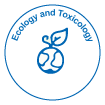Ecotoxicological Effects of Nanoparticles on Soil Microbiota and Plant Growth
Received: 30-Dec-2024 / Manuscript No. jety-25-161236 / Editor assigned: 02-Jan-2025 / PreQC No. jety-25-161236 / Reviewed: 18-Jan-2025 / QC No. jety-25-161236(QC) / Revised: 22-Jan-2025 / Manuscript No. jety-25-161236( R) / Published Date: 30-Jan-2025 DOI: 10.4172/jety.1000259
Abstract
Nanoparticle contamination in terrestrial ecosystems has become an emerging environmental concern, particularly regarding its effects on soil microbiota and plant growth. These nanoparticles, originating from industrial, agricultural, and biomedical applications, alter soil properties, microbial diversity, and plant physiological processes. This study examines the ecotoxicological impacts of nanoparticles on soil microbial communities, their potential to disrupt plantmicrobe interactions, and subsequent effects on plant health and development. The findings highlight the urgent need for regulatory frameworks and sustainable alternatives to mitigate nanoparticle pollution in agricultural and natural environments.
Introduction
The increasing use of engineered nanoparticles (NPs) in various industries has led to their inadvertent release into the environment, raising concerns about their impact on soil ecosystems. Nanoparticles, defined as materials with at least one dimension less than 100 nm, have unique physicochemical properties that can interact with biological systems in unpredictable ways. Soil microbiota, which play a crucial role in nutrient cycling, organic matter decomposition, and plant health, are particularly vulnerable to NP exposure. Additionally, nanoparticles can directly influence plant growth by altering soil properties, nutrient availability, and root-microbe interactions. This article aims to evaluate the ecotoxicological effects of nanoparticles on soil microbial communities and plant development, with an emphasis on potential environmental risks and mitigation strategies [1].
Discussion
Nanoparticles enter soil systems through various pathways, including industrial waste, agricultural inputs, and atmospheric deposition. Common nanoparticles such as silver (AgNPs), titanium dioxide (TiO2 NPs), and zinc oxide (ZnO NPs) persist in soil, influencing physicochemical properties such as pH, redox potential, and cation exchange capacity. These alterations can impact microbial community composition and soil fertility. The introduction of nanoparticles into soil can induce both toxic and stimulatory effects on microbial populations. Some nanoparticles exhibit antimicrobial properties, reducing bacterial and fungal diversity, while others may enhance microbial activity by providing additional surfaces for colonization. Key concerns include disruption of nitrogen-fixing bacteria, inhibition of enzymatic processes, and changes in microbial-mediated nutrient cycling. The long-term implications of these changes could lead to soil degradation and reduced agricultural productivity. Nanoparticles can affect plants through direct uptake via roots or indirect alterations in soil chemistry. Some NPs, such as TiO2 and ZnO, have been reported to enhance seed germination and plant growth at low concentrations, while others, like AgNPs, exhibit phytotoxicity by generating oxidative stress and inhibiting root elongation. Additionally, the impact of nanoparticles on symbiotic relationships, such as mycorrhizal associations, further influences plant nutrient uptake and overall health. To minimize the adverse effects of nanoparticles on soil and plant ecosystems, it is essential to develop sustainable management strategies. These include the application of biochar, organic amendments, and phytoremediation techniques to immobilize or degrade nanoparticles in soil. Regulatory policies should also focus on limiting nanoparticle emissions and promoting environmentally friendly alternatives to safeguard soil health and agricultural sustainability [2-5].
Conclusion
The ecotoxicological effects of nanoparticles on soil microbiota and plant growth present a significant environmental challenge. While some nanoparticles may offer agricultural benefits at controlled levels, their widespread and unregulated use poses risks to soil microbial diversity and plant development. Further research is required to fully understand the long-term consequences of nanoparticle contamination and to establish effective mitigation measures. Collaborative efforts between scientists, policymakers, and industries are crucial in ensuring the responsible use of nanotechnology while protecting terrestrial ecosystems.
Acknowledgment
None
Conflict of Interest
None
References
- Vinoth R, Kumaravel S, Ranganathan R (2019).JDDT 9: 849–854.
- Nabeelah Bibi S, Fawzi MM, Gokhan Z, Rajesh J, Nadeem N, et al. (2019) .Mar Drugs 17: 231.
- Yuvaraj N, Kanmani P, Satishkumar R, Paari A, Arul V (2012).Pharm Biol 50: 458–467.
- Bel Mabrouk S, Reis M, Sousa ML, Ribeiro T, Almeida JR, et al. (2020).Mar Drugs 18: 88.
- Smit AJ (2004).J Appl Phycol16: 245–262
,
, ,
, ,
, ,
,
Citation: Lina H (2025) Ecotoxicological Effects of Nanoparticles on Soil Microbiota and Plant Growth. J Ecol Toxicol, 9: 259 DOI: 10.4172/jety.1000259
Copyright: 漏 2025 Lina H. This is an open-access article distributed under the terms of the Creative Commons Attribution License, which permits unrestricted use, distribution, and reproduction in any medium, provided the original author and source are credited.
Share This Article
Recommended Journals
Open 91桃色 Journals
Article Tools
Article Usage
- Total views: 123
- [From(publication date): 0-0 - Apr 25, 2025]
- Breakdown by view type
- HTML page views: 51
- PDF downloads: 72
